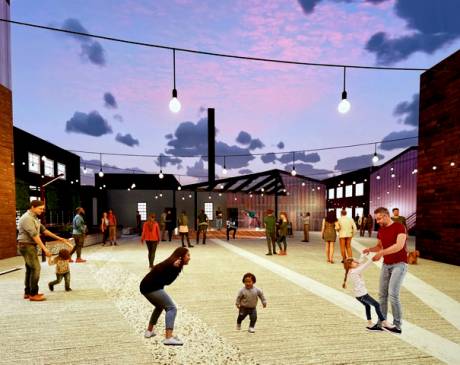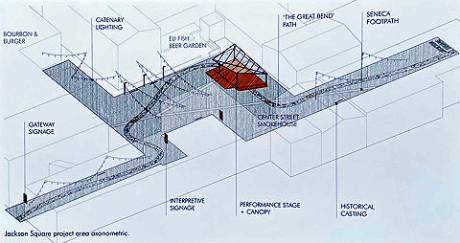Form over function? Promoters of The Ramble Music Fest not in tune with Jackson Square stage design elements

The redesigned Jackson Square looks great, but is it functional?
That’s a question that promoters of The Batavia Ramble Music & Arts Festival are hoping City of Batavia officials and representatives of Architectural Resources consider before breaking ground on the Downtown Revitalization Initiative project later this year.
“They’re putting too much emphasis on the artistic aspect of the design and they’re forgetting about the practicality of what it is used for,” said Stephen Kowalczyk, who has been involved in sound, lighting and (recently) administration of The Ramble since its inception 13 years ago.
Kowalczyk expressed his opinion this afternoon – a day after community residents made their way to the venue between Jackson and Center streets near Center Street Smoke House for an informational meeting set up by city leaders and the Buffalo design firm hired to bring new life to the property.
Enhancing Jackson Square is being funded by a strategic investment grant of $750,000 from the New York State DRI program.
Kowalczyk and co-promoter Paul Draper said their main issues are with components of the proposed stage – its configuration, roofing material, its height and placement of a handicap ramp. He said they gave suggestions to the architect previously, but believe their input was disregarded.
City Manager Rachel Tabelski, in an email message this afternoon, did report that The Ramble musicians requested officials to re-examine the sound acoustics, specifically the “current canopy design of the stage and the materiality of the canopy as well as the stage height and the ramp access point to the stage.”
She said the city will work with Architectural Resources to modify the design to accommodate the commentary, including the canopy and stage.
“We want the citizens of Batavia to utilize Jackson Square for a multitude of events and will continue to work through design to get it correct,” she said.
Kowalczyk provided his “blueprint” for making the area not only attractive but practical:
- Changing the stage's proposed glass roof to wood with 50-year metal roofing over it.
He said a see-through roof idea is not appropriate for the setting.
“Maybe in an open park it might work but it does not work in a concrete jungle that is Jackson Square,” he said. “It’s already an acoustical nightmare because of all the concrete walls, and they’re just going to make it worse by adding more reflective surfaces that are angled inappropriately to the way a band would be on stage.”
- Changing the stage from the proposed oblong shape to a rectangle.
“There are no right angles on the stage. Every single cut that they’re going to have to make in building this is going to be an odd angle that will take more resources and time to build,” he said. “We’re just asking for a simple rectangle stage with a normal roof on it so the band can have its gear protected and have some shade from the sun.”
- Keeping the height of the stage at 30 inches instead of the proposed 16 and moving a new handicap ramp from the front of the stage to behind it to avoid having to go over any cables and wires.
“The height of the stage is the biggest thing that’s killing me,” he said. “They’re cutting the stage almost in half, which means anyone further back is not going to be able to see anything.”
Kowalczyk said the proposed design “is not functional or practical for any live event out there except maybe a poetry slam.”
“They kept talking about a poetry slam. For someone who has done acoustic shows there, with the motorcycles and trucks going by, you can’t get away with doing anything with the spoken word. It’s too noisy.”
He said he was hoping to attract band recitals and start movie nights, but the stage reconfiguration would make it difficult to hang banners or a projector screen.
Draper said he thinks the architect had “good intentions but they were considering the design more than the utility of the event space.”
“It seems like they could have done a better job if they would have listened to people who actually utilize the space,” he added.
Tabelski said that the pavement and lighting element feedback was “all positive.”
“The concept integrates many historical layers of Batavia including the Great Bend -- changing the trajectory of the Tonawanda Creek -- the Ancient Seneca Footpaths and the history of ‘old’ downtown Batavia,” she said.
Following approval of the final design concept, the project will move to the construction bidding phase. Groundbreaking is expected this fall, with completion anticipated next spring.
A call to Justina Dziama of Architectural Design this morning was not returned.


Architect renderings of the proposed Enhanced Jackson Square project.
